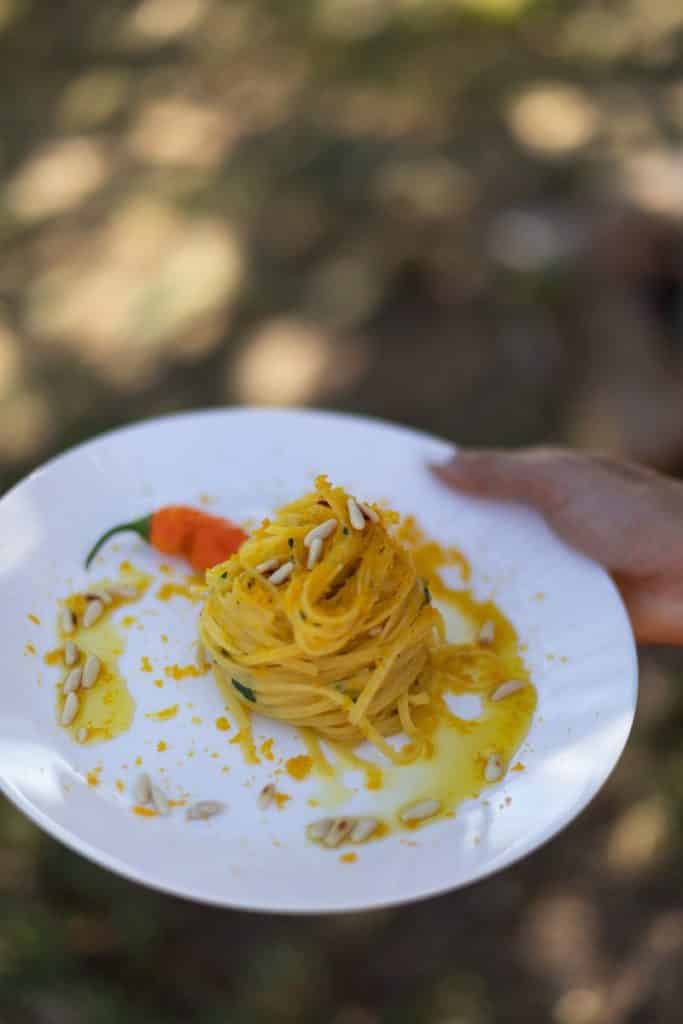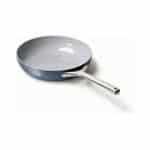If we had to create a tagline for our time in Italy working with Lucini Italia it would have to be “quality is king.”
Over the course of filming the 5-part “Behind The Bottle” video series — where we dive deep into all things quality olive oil (and cover every gorgeous corner of Tuscany) — everyone we met was committed to crafting and consuming the best possible quality possible. One such family was the Salvadoris who produce some of Lucini’s signature premium extra-virgin olive oil in the southern area of Tuscany known as Alta Maremma.
Getting To Know Alta Maremma
Our visit with this multi-generational family of producers taught us a thing or three about olive oil. We talked about why Tuscan olive oil is so distinct (hint: it comes down to the olive varieties and the climate), about the role olive trees played in Tuscany in WWII (when Tuscans turned to the olive tree to eat olives for sustenance and the wood for fuel), and, of course, their passion for producing olive oil. The family has such love for their olives that they’ve practically named every tree and strolled through the groves on the regular to visit and check upon them.
While Romina works with her parents and her husband to run all things olive oil, her sister, Rita, has a chili pepper farm named Peperita (as in Peppers and Rita!) just down the road.
Across Italy Rita has made a name for herself with her top-quality chili peppers and, of course, works with her family to infuse their olive oils among other products. Over a sunny summer afternoon, the Salvadori family invited us over to cook, chat, and eat like they do almost every Sunday.
What Is Bibbonata?
During the meal featured in the video, we cooked this pasta recipe known as “Bibbonata.” Rita created this simple but insanely delicious dish a decade ago as a sort of love letter slash homage to their hometown of Bibbona. The small town of Bibbona is smack dab in the middle of Alta Maremma (aka the Tuscan Riviera), which just happens to be one of the most celebrated corners of Italy for quality ingredients.
How Do You Make Bibbonata?
This pasta uses ingredients from across the regions including farm homemade tagliolini egg pasta, fresh garlic and parsley, bottarga (salted and dried fish roe) from the nearby town of Orbetello, pine nuts from Pisa, chili peppers from Rita’s farm, and, of course, premium extra-virgin olive oil!
There are only a handful of ingredients in this dish so it’s essential that every item be top quality. So splurge a little on the ingredients, cook this up, finish it with a generous amount of olive oil, give it a taste, and toast the idea that quality is indeed king!
Now go stock up on all your cooking essentials, then head into the kitchen, make this, and share it with us by tagging @saltandwind and #swsociety on social!


{Bibbonata} Pine Nuts and Bottarga Tagliolini Pasta Recipe
Equipment
Ingredients
- 2 tablespoons pine nuts
- 12 ounces tagliolini pasta or spaghetti
- 1/4 cup extra-virgin olive oil plus more for garnish
- 1 medium garlic clove sliced paper thin
- 1 or 2 medium scotch bonnet chili pepper or fresno chilis, seeded and stemmed then thinly sliced
- 1 ounce bottarga shaved on a mandolin or with a very sharp knife into paper thin slices
- 1 handful finely chopped flat Italian parsley for garnish
- Zest of 1/2 medium lemon for garnish
Instructions
- Toast The Pine Nuts: Bring a large pot of heavily salted water to boil over high heat. Meanwhile, toast the pine nuts in a small nonstick frying pan over medium-low heat until golden brown on one side. Immediately remove from heat and set aside until ready to use.
- Cook The Pasta: When the water boils, add the pasta and cook until just al dente. While the pasta cooks, cook the sauce by heating the olive oil in a large nonstick pan over medium-low heat. Add the garlic and chili pepper and cook until the chili is fragrant and the garlic just begins to soften about two minutes.
- Drain the pasta and add a couple of spoonfuls of the pasta cooking water directly to the pan with the garlic and chili. Immediately add the parsley, lemon, and half of the bottarga, stir to incorporate, taste, and add salt as desired.
- Toss The Pasta In The Sauce: Use tongs or forks to twirl each portion of pasta into a "nest" shape, then place on a serving plate. Top with the toasted pine nuts, a few shavings of bottarga, and a drizzle of olive oil. Serve immediately.






